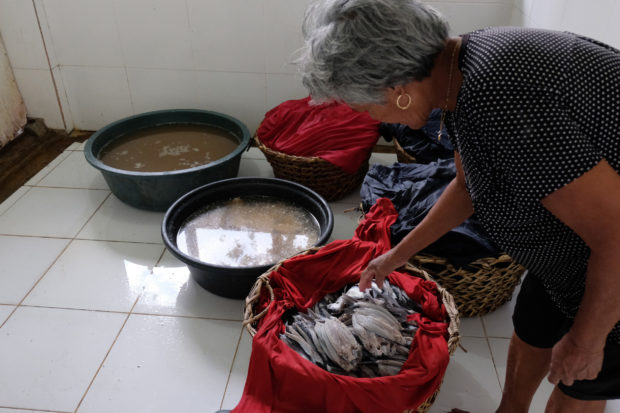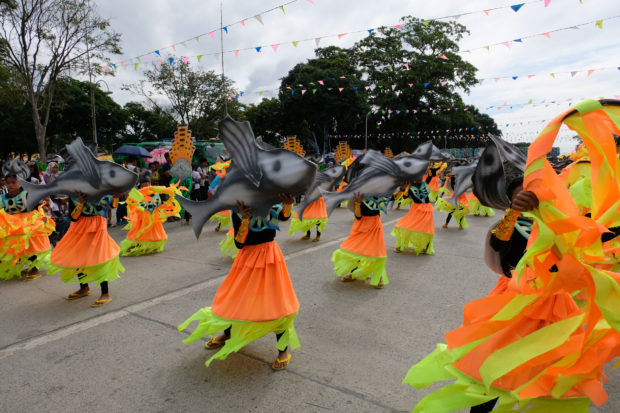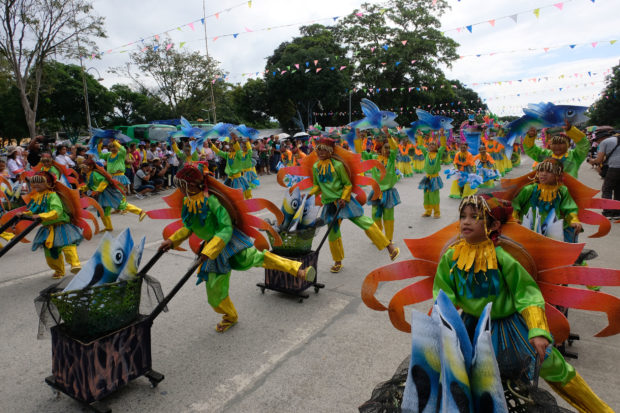Town’s fortune, future soar with flying fish

Residents and visitors feast on free lunch of grilled fresh and marinated bangsi during the culmination of the 13th Bangsi Festival on January 23, 2020 in Maitum, Sarangani. PHOTO BY BONG S. SARMIENTO
MAITUM, Sarangani, Philippines — When Maribel Reroma was starting a family more than a decade ago, she and her husband only had meager savings from their low-paying jobs.
Raising two children added financial pressure on Reroma, a high school dropout, who tried her luck at selling “bangsi” (flying fish), which is abundant in this coastal town of Maitum, Sarangani province.
She sold marinated bangsi, and like others before her, she encountered failure several times.
“I did not surrender until business began to pick up,” Reroma tells the Inquirer.
Through sheer grit, she morphed from vendor to producer. Today, she supplies wet market stalls and grocery stores in the Soccsksargen (South Cotabato, Cotabato, Sultan Kudarat, Sarangani and General Santos) region. She has expanded her business to trading of bagoong (fermented fish sauce), vegetables and fruits.
Article continues after this advertisementAccording to Reroma, her fish venture can process up to 500 kilograms of marinated bangsi, depending on supply. Apart from buying bangsi from local fishers, she acquired a boat solely for catching flying fish.
Article continues after this advertisementBlessing
“Bangsi has been a big blessing to our family,” said the 45-year-old mother of four.
For many others in Maitum, a second-class municipality of 45,000 who are predominantly descendants of Ilocano migrants, the lowly fish has helped build a bright future for its children.

A woman in Barangay Old Poblacion, Maitum Sarangani shows the processing of marinated bangsi. PHOTO BY BONG S. SARMIENTO
Around 1,000 families depend on the bangsi industry for livelihood, according to the town mayor, Alexander Bryan Reganit.
The fish abounds in the waters of Maitum and neighboring areas by the Celebes Sea and Sarangani Bay. Municipal government data showed the volume of the fish unloaded last year at the port reached 324,909 kg.
In the 1970s, bangsi bounty, coupled by the lack of access to larger markets, dampened prices that fishers were offered for their catch, Reganit recalled.
Stable income
He said three entrepreneurial women of Barangay Old Poblacion experimented with marinating bangsi to improve its taste. When it became a hit in the market, the fishers’ fortunes began to fly, “and the rest was history,” according to the mayor.
Mass production of half-dried marinated bangsi began in the 1980s, driving demand for the fish and providing stable income for fishers.
The product sells for P90 to P120 per half-kilo pack.
The fish is best eaten crispy fried, although others prefer grilled.

Performers show their wares during the culmination of the 13th Bangsi Festival on January 23, 2020 in Maitum, Sarangani. PHOTO BY BONG S. SARMIENTO

Performers show their wares during the culmination of the 13th Bangsi Festival on January 23, 2020 in Maitum, Sarangani. PHOTO BY BONG S. SARMIENTO
Bangsi’s popularity further grew when the local government chose it for its “One Town, One Product” initiative.
Maitum offered bangsi as a gastronomic takeaway, apart from its tourist destinations, especially its sanctuary of giant bats, river tire-tubing adventure and prehistoric jars that put the town on the archaeological map.
Today, a visit to Sarangani is said to be incomplete without a “pasalubong” of bangsi.
Tribute
As tribute to the fish, Maitum has been staging since 2008 the Bangsi Festival, which aims to promote the marinated bangsi and the tourism potentials of the town. It culminates in a street dancing contest inspired by the fish and free lunch of charcoal-grilled fresh and marinated bangsi.
During the recent weeklong festivities, which carried the theme “Lipad Maitum Para sa Kasaganaan” (Soar Maitum for Abundance), local officials ordered at least 300 kg of marinated bangsi for merrymakers to feast on, apart from the fresh catch.
Live band performances, motocross, “bancarera” (fishing boat race), Zumba with foam party, acrobatic shows and a bangsi cooking contest were among the events.

Fishing boats line up the coast of Maitum, Sarangani for the race on January 22, 2020 that’s parts of the annual celebration of the Bangsi Festival. PHOTO BY BONG S. SARMIENTO
“We are promoting this festival to boost the morale of our fisherfolk and the women engaged in marinated bangsi production as well as [to showcase] our diverse culture, tourism and economy,” Reganit said. He urged the people to protect and conserve local marine resources in order to sustain the bangsi industry.
“Without a sound coral reef ecosystem, we will not be able to nurture the biodiversity of marine life which give our people food and livelihood,” Reganit said.